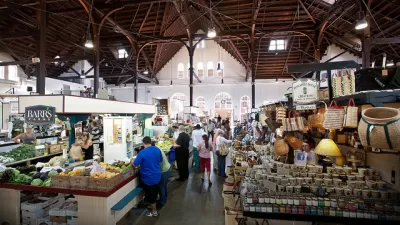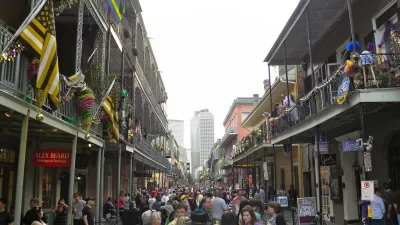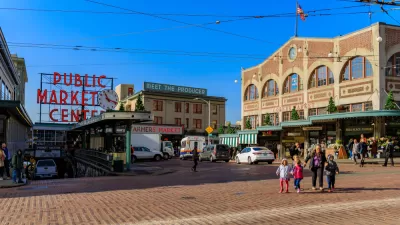What constitutes a farmers' market, rather than an outdoor or public market?
Farmers' markets serve many purposes. Eponymously, and most simply, they are venues at which farmers can sell their products to consumers. They also serve as community gathering places, offering a festive environment in which to meet friends, taste new foods, and perhaps get lunch while shopping for the week's produce.
A few weeks ago we took out of town friends to the Saturday market at the San Francisco Ferry Building. We never actually made it to the shops inside the Ferry Building, loading up on stone fruit, tayberries, lamb, rice, fish, eggs, asparagus, and a huge assortment of greens from the outdoor farm stands. We also purchased farm-made almond paste, honey, and jam—the only processed foods we procured that day. We lugged our bounty home and prepared a locally grown feast. Our friends, having just come through one of the worst winters in Chicago's memory, were overjoyed by the late spring abundance that Northern Californians take for granted.
Two weeks later, walking through the Saturday market in Burlington, Vermont, I was struck by how different the meaning of "farmers' market" is here compared to San Francisco. Of course it is earlier in the Vermont growing season; even though it is the summer solstice, the hearty chard and delicate garlic scapes on display confirm early season harvests. The social importance of this space, occupying a park and a blocked-off city street, is evident; people are glad to see each other, savoring the sun and the newly warm weather. Children getting their faces painted add to the carnival atmosphere.
Searching for additional indicators of Vermont spring agriculture, I am struck by the scarcity of unprocessed products. A small handful of stands sell fresh produce: winter greens, garlic scapes, and strawberries bear witness to the transition from winter to spring agriculture. Several vendors offer fresh meat. One stall displays beautiful cut flowers. Jams, pickles, and other preserved foods are for sale, as well as a delicacy unavailable on the west coast: fresh maple syrup. Yet the majority of the stalls proffer baked goods, cheese, charcuterie, prepared foods to eat there, or non-edible products like beeswax candles, essential oils, clothes, pottery, and handmade wooden rolling pins. Multiple vendors offer maple-sweetened lemonade and iced tea, each with an improbably long line. Those shoppers who have eschewed lemonade are holding cups of coffee.
Most remarkable to me are the several booths selling locally brewed, distilled, and vinted beers, liquor, and wines. Astonishingly, samples are available to shoppers over the age of 21. I watch the producers pour tiny cups of their merchandise for shoppers who look appropriately serious and discerning as they taste the proffered elixirs. This isn’t permitted where I live, despite our region’s celebrated wine industry and fixation on "mixology."
I stroll away, reflecting. Like the old light bulb jokes, I wonder: How many farmers does it take to create a Farmers' Market? What is a Farmers' Market?

Maui's Vacation Rental Debate Turns Ugly
Verbal attacks, misinformation campaigns and fistfights plague a high-stakes debate to convert thousands of vacation rentals into long-term housing.

Planetizen Federal Action Tracker
A weekly monitor of how Trump’s orders and actions are impacting planners and planning in America.

San Francisco Suspends Traffic Calming Amidst Record Deaths
Citing “a challenging fiscal landscape,” the city will cease the program on the heels of 42 traffic deaths, including 24 pedestrians.

Defunct Pittsburgh Power Plant to Become Residential Tower
A decommissioned steam heat plant will be redeveloped into almost 100 affordable housing units.

Trump Prompts Restructuring of Transportation Research Board in “Unprecedented Overreach”
The TRB has eliminated more than half of its committees including those focused on climate, equity, and cities.

Amtrak Rolls Out New Orleans to Alabama “Mardi Gras” Train
The new service will operate morning and evening departures between Mobile and New Orleans.
Urban Design for Planners 1: Software Tools
This six-course series explores essential urban design concepts using open source software and equips planners with the tools they need to participate fully in the urban design process.
Planning for Universal Design
Learn the tools for implementing Universal Design in planning regulations.
Heyer Gruel & Associates PA
JM Goldson LLC
Custer County Colorado
City of Camden Redevelopment Agency
City of Astoria
Transportation Research & Education Center (TREC) at Portland State University
Jefferson Parish Government
Camden Redevelopment Agency
City of Claremont






























